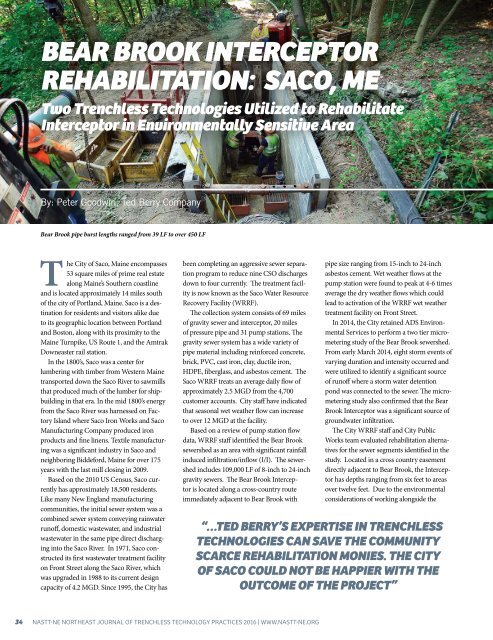PRACTICES
nastt-ne-journal-2016
nastt-ne-journal-2016
Create successful ePaper yourself
Turn your PDF publications into a flip-book with our unique Google optimized e-Paper software.
BEAR BROOK INTERCEPTOR<br />
REHABILITATION: SACO, ME<br />
Two Trenchless Technologies Utilized to Rehabilitate<br />
Interceptor in Environmentally Sensitive Area<br />
By: Peter Goodwin, Ted Berry Company<br />
Bear Brook pipe burst lengths ranged from 39 LF to over 450 LF<br />
The City of Saco, Maine encompasses<br />
53 square miles of prime real estate<br />
along Maine’s Southern coastline<br />
and is located approximately 14 miles south<br />
of the city of Portland, Maine. Saco is a destination<br />
for residents and visitors alike due<br />
to its geographic location between Portland<br />
and Boston, along with its proximity to the<br />
Maine Turnpike, US Route 1, and the Amtrak<br />
Downeaster rail station.<br />
In the 1800’s, Saco was a center for<br />
lumbering with timber from Western Maine<br />
transported down the Saco River to sawmills<br />
that produced much of the lumber for shipbuilding<br />
in that era. In the mid 1800’s energy<br />
from the Saco River was harnessed on Factory<br />
Island where Saco Iron Works and Saco<br />
Manufacturing Company produced iron<br />
products and fine linens. Textile manufacturing<br />
was a significant industry in Saco and<br />
neighboring Biddeford, Maine for over 175<br />
years with the last mill closing in 2009.<br />
Based on the 2010 US Census, Saco currently<br />
has approximately 18,500 residents.<br />
Like many New England manufacturing<br />
communities, the initial sewer system was a<br />
combined sewer system conveying rainwater<br />
runoff, domestic wastewater, and industrial<br />
wastewater in the same pipe direct discharging<br />
into the Saco River. In 1971, Saco constructed<br />
its first wastewater treatment facility<br />
on Front Street along the Saco River, which<br />
was upgraded in 1988 to its current design<br />
capacity of 4.2 MGD. Since 1995, the City has<br />
been completing an aggressive sewer separation<br />
program to reduce nine CSO discharges<br />
down to four currently. The treatment facility<br />
is now known as the Saco Water Resource<br />
Recovery Facility (WRRF).<br />
The collection system consists of 69 miles<br />
of gravity sewer and interceptor, 20 miles<br />
of pressure pipe and 31 pump stations. The<br />
gravity sewer system has a wide variety of<br />
pipe material including reinforced concrete,<br />
brick, PVC, cast iron, clay, ductile iron,<br />
HDPE, fiberglass, and asbestos cement. The<br />
Saco WRRF treats an average daily flow of<br />
approximately 2.5 MGD from the 4,700<br />
customer accounts. City staff have indicated<br />
that seasonal wet weather flow can increase<br />
to over 12 MGD at the facility.<br />
Based on a review of pump station flow<br />
data, WRRF staff identified the Bear Brook<br />
sewershed as an area with significant rainfall<br />
induced infiltration/inflow (I/I). The sewershed<br />
includes 109,000 LF of 8-inch to 24-inch<br />
gravity sewers. The Bear Brook Interceptor<br />
is located along a cross-country route<br />
immediately adjacent to Bear Brook with<br />
pipe size ranging from 15-inch to 24-inch<br />
asbestos cement. Wet weather flows at the<br />
pump station were found to peak at 4-6 times<br />
average the dry weather flows which could<br />
lead to activation of the WRRF wet weather<br />
treatment facility on Front Street.<br />
In 2014, the City retained ADS Environmental<br />
Services to perform a two tier micrometering<br />
study of the Bear Brook sewershed.<br />
From early March 2014, eight storm events of<br />
varying duration and intensity occurred and<br />
were utilized to identify a significant source<br />
of runoff where a storm water detention<br />
pond was connected to the sewer. The micrometering<br />
study also confirmed that the Bear<br />
Brook Interceptor was a significant source of<br />
groundwater infiltration.<br />
The City WRRF staff and City Public<br />
Works team evaluated rehabilitation alternatives<br />
for the sewer segments identified in the<br />
study. Located in a cross country easement<br />
directly adjacent to Bear Brook, the Interceptor<br />
has depths ranging from six feet to areas<br />
over twelve feet. Due to the environmental<br />
considerations of working alongside the<br />
“…TED BERRY’S EXPERTISE IN TRENCHLESS<br />
TECHNOLOGIES CAN SAVE THE COMMUNITY<br />
SCARCE REHABILITATION MONIES. THE CITY<br />
OF SACO COULD NOT BE HAPPIER WITH THE<br />
OUTCOME OF THE PROJECT”<br />
34 NASTT-NE NORTHEAST JOURNAL OF TRENCHLESS TECHNOLOGY <strong>PRACTICES</strong> 2016 | WWW.NASTT-NE.ORG


